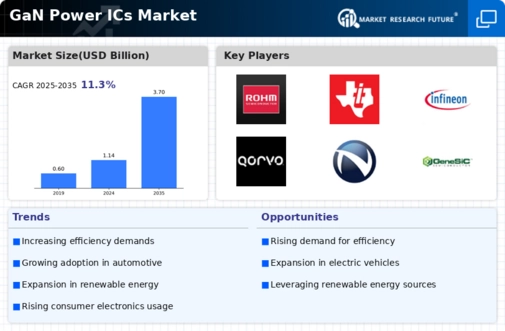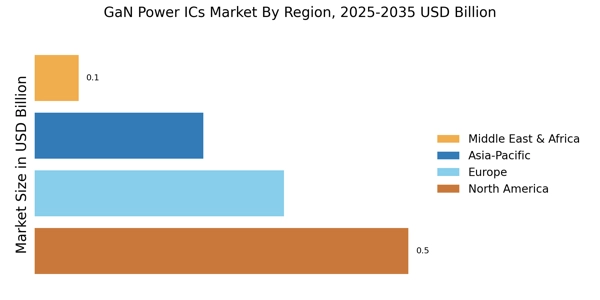Growth in Renewable Energy Systems
The growth in renewable energy systems is a crucial driver for the GaN Power ICs Market. As nations strive to meet renewable energy targets, the integration of efficient power electronics becomes essential. GaN Power ICs Market facilitate the conversion and management of energy from renewable sources such as solar and wind, enhancing overall system efficiency. The International Energy Agency has reported a significant increase in renewable energy capacity, which is expected to continue expanding. This trend indicates a rising need for advanced power management solutions, where GaN technology can play a vital role. The ability of GaN devices to operate at higher frequencies and temperatures makes them ideal for renewable energy applications, thereby fostering their adoption in this rapidly evolving sector.
Surge in Electric Vehicle Production
The surge in electric vehicle (EV) production is significantly influencing the GaN Power ICs Market. As automakers increasingly transition to electric drivetrains, the demand for efficient power management solutions becomes paramount. GaN Power ICs Market are particularly well-suited for EV applications due to their ability to handle high voltages and currents while maintaining low energy losses. Industry forecasts suggest that the EV market could reach a valuation of several trillion dollars by the end of the decade, which would inherently drive the demand for GaN-based power solutions. This transition not only supports the automotive sector's shift towards sustainability but also positions GaN technology as a critical component in the future of transportation, thereby enhancing its market presence.
Increasing Adoption of GaN Technology
The increasing adoption of GaN technology in power electronics is a pivotal driver for the GaN Power ICs Market. GaN devices offer superior efficiency and performance compared to traditional silicon-based solutions, which is particularly appealing in applications requiring high power density. As industries such as telecommunications and consumer electronics seek to enhance their energy efficiency, the demand for GaN Power ICs Market is expected to rise. Reports indicate that the market for GaN devices is projected to grow at a compound annual growth rate (CAGR) of over 20% in the coming years, reflecting a robust shift towards advanced semiconductor technologies. This trend is likely to be fueled by the need for smaller, lighter, and more efficient power solutions across various sectors, thereby solidifying the position of GaN technology in the power IC landscape.
Demand for Compact and Lightweight Solutions
The demand for compact and lightweight solutions in various electronic applications is propelling the GaN Power ICs Market forward. As consumer electronics, telecommunications, and industrial equipment evolve, there is a growing need for power solutions that occupy less space and weigh less. GaN Power ICs Market, known for their high efficiency and small form factor, are increasingly being utilized to meet these requirements. Market analysis indicates that the trend towards miniaturization in electronics is likely to continue, with many devices requiring power solutions that do not compromise on performance. This shift towards smaller, more efficient power ICs is expected to drive the adoption of GaN technology, as manufacturers seek to enhance product design while maintaining energy efficiency.
Regulatory Push for Energy Efficiency Standards
The regulatory push for energy efficiency standards is a significant driver for the GaN Power ICs Market. Governments and regulatory bodies worldwide are implementing stringent energy efficiency regulations aimed at reducing carbon emissions and promoting sustainable practices. These regulations often necessitate the adoption of advanced power electronics, where GaN Power ICs Market can provide substantial benefits. As industries adapt to comply with these standards, the demand for GaN technology is likely to increase. Reports suggest that compliance with energy efficiency regulations can lead to substantial cost savings for manufacturers, further incentivizing the shift towards GaN solutions. This regulatory environment not only fosters innovation in power electronics but also positions GaN technology as a key player in achieving energy efficiency goals.
















Leave a Comment